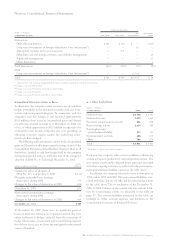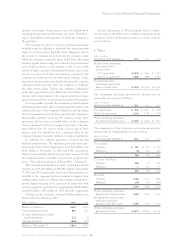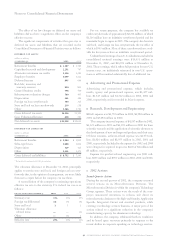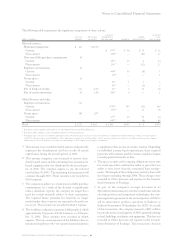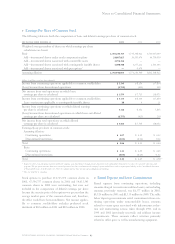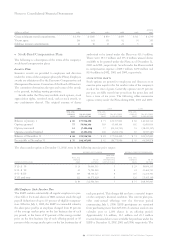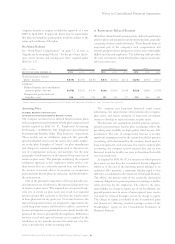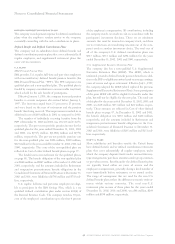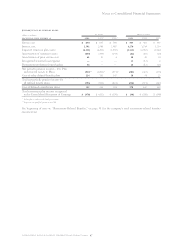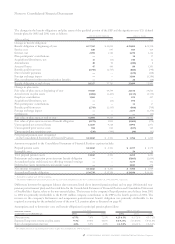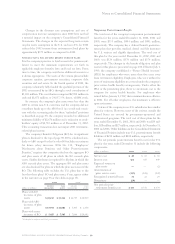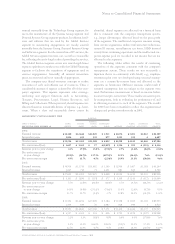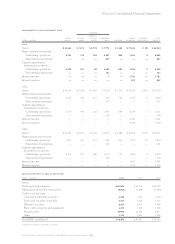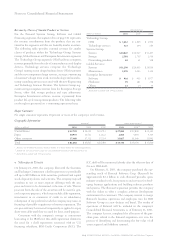IBM 2002 Annual Report Download - page 98
Download and view the complete annual report
Please find page 98 of the 2002 IBM annual report below. You can navigate through the pages in the report by either clicking on the pages listed below, or by using the keyword search tool below to find specific information within the annual report.
Notes to Consolidated Financial Statements
96 international business machines corporation and Subsidiary Companies
defined contribution pension plans
The company records pension expense for defined contribution
plans when the employee renders service to the company,
essentially coinciding with the cash contributions to plans.
Defined Benefit and Defined Contribution Plans
The company and its subsidiaries have defined benefit and
defined contribution pension plans that cover substantially all
regular employees, and supplemental retirement plans that
cover certain executives.
u.s. plans
IBM Personal Pension Plan
IBM provides U.S. regular, full-time and part-time employees
with noncontributory defined benefit pension benefits (the
IBM Personal Pension Plan, “PPP”). The PPP comprises a tax
qualified plan and a non-qualified plan. The qualified plan is
funded by company contributions to an irrevocable trust fund,
which is held for the sole benefit of participants.
Effective January 1, 2001, the company increased pension
benefits to certain recipients who retired before January 1,
1997. The increases ranged from 2.5 percent to 25 percent,
and were based on the year of retirement and the pension
benefit then being received. This improvement resulted in an
additional cost of $100 million in 2001 as compared to 2000.
The number of individuals receiving benefits from the
PPP at December 31, 2002 and 2001, was 136,365 and 131,071,
respectively. The pre-tax net periodic pension income for the
qualified plan for the years ended December 31, 2002, 2001
and 2000, was $(917) million, $(1,086) million and $(971)
million, respectively. The pre-tax net periodic pension cost
for the non-qualified plan was $106 million, $118 million,
$123 million for the years ended December 31, 2002, 2001 and
2000, respectively. The costs of the non-qualified plan are
reflected in Cost of other defined benefit plans on page 97.
The funded status reconciliation for the qualified plan is
on page 98. The benefit obligation of the non-qualified plan
was $940 million and $847 million at December 31, 2002 and
2001, respectively, and the amounts included in Retirement
and nonpension postretirement benefit obligations in the
Consolidated Statement of Financial Position at December 31,
2002 and 2001, were liabilities of $798 million and $738 mil-
lion, respectively.
U.S. regular, full-time and part-time employees are eligi-
ble to participate in the IBM Savings Plan, which is a tax
qualified defined contribution plan under section 401(k) of
the Internal Revenue Code. The company matches 50 per-
cent of the employee’s contribution up to the first 6 percent
of the employee’s compensation. All contributions, including
the company match, are made in cash, in accordance with the
participants’ investment elections. There are no minimum
amounts that must be invested in company stock, and there
are no restrictions on transferring amounts out of the com-
pany’s stock to another investment choice. The total cost of
all of the company’s U.S. defined contribution plans was
$315 million, $313 million and $294 million for the years
ended December 31, 2002, 2001 and 2000, respectively.
U.S. Supplemental Executive Retention Plan
The company also has a non-qualified U.S. Supplemental
Executive Retention Plan (SERP). The SERP, which is
unfunded, provides defined benefit pension benefits in addi-
tion to the PPP to eligible executives based on average earnings,
years of service and age at retirement. Effective July 1, 1999,
the company adopted the SERP (which replaced the previous
Supplemental Executive Retirement Plan). Some participants
of the prior SERP will still be eligible for benefits under that
plan, but will not be eligible for the new plan. The total cost
of this plan for the years ended December 31, 2002, 2001 and
2000, was $18 million, $23 million and $24 million, respec-
tively. These amounts are reflected in Cost of other defined
benefit plans on page 97. At December 31, 2002 and 2001,
the benefit obligation was $130 million and $166 million,
respectively, and the amounts included in Retirement and
nonpension postretirement benefit obligations in the Con-
solidated Statement of Financial Position at December 31,
2002 and 2001, were liabilities of $165 million and $151 mil-
lion, respectively.
non-u.s. plans
Most subsidiaries and branches outside the United States
have defined benefit and/or defined contribution retirement
plans that cover substantially all regular employees, under
which the company deposits funds under various fiduciary-
type arrangements, purchases annuities under group contracts
or provides reserves. Benefits under the defined benefit plans
are typically based either on years of service and the
employee’s compensation, generally during a fixed number of
years immediately before retirement, or on annual credits.
The range of assumptions that are used for the non-U.S.
defined benefit plans reflect the different economic environ-
ments within various countries. The total non-U.S.
retirement plan income of these plans for the years ended
December 31, 2002, 2001 and 2000, was $46 million, $209
million and $198 million, respectively.


